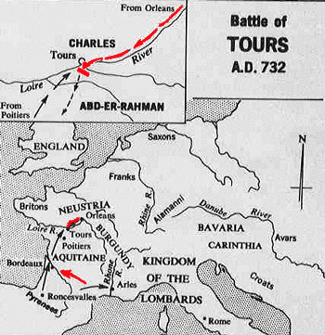|
Battle of Tours October 10, 732 AD marks the conclusion of the Battle of Tours, arguably one of the most decisive battles in all of history. A Moslem army, in a crusading search for land and the end of Christianity, after the conquest of Syria, Egypt, and North Africa, began to invade Western Europe under the leadership of Abd-er Rahman, governor of Spain. Abd-er Rahman led an infantry of 60,000 to 400,000 soldiers across the Western Pyrenees and toward the Loire River, but they were met just outside the city of Tours by Charles Martel, known as the Hammer, and the Frankish Army.
Martel gathered his forces directly in the path of the oncoming Moslem army and prepared to defend themselves by using a phalanx style of combat. The invading Moslems rushed forward, relying on the slashing tactics and overwhelming number of horsemen that had brought them victories in the past. However, the French Army, composed of foot soldiers armed only with swords, shields, axes, javelins, and daggers, was well trained. Despite the effectiveness of the Moslem army in previous battles, the terrain caused them a disadvantage. Their strength lied within their cavalry, armed with large swords and lances, which along with their baggage mules, limited their mobility. The French army displayed great ardency in withstanding the ferocious attack. It was one of the rare times in the Middle Ages when infantry held its ground against a mounted attack. The exact length of the battle is undetermined; Arab sources claim that it was a two day battle whereas Christian sources hold that the fighting clamored on for seven days. In either case, the battle ended when the French captured and killed Abd-er Rahman. The Moslem army withdrew peacefully overnight and even though Martel expected a surprise retaliation, there was none. For the Moslems, the death of their leader caused a sharp setback and they had no choice but to retreat back across the Pyrenees, never to return again. Not only did this prove to be an extremely decisive battle for the Christians, but the Battle of Tours is considered the high water mark of the Moslem invasion of Western Europe. Bibliography: A Dictionary of Battles, Eggenberger, David. Thomas Y. Crowell Company, 1967 Battlefields of Europe, Edited by David Chandler. Hugh Evelyn Ltd,1965 The Cambridge Medival History Volume IV, Planned by J.B. Bory, M.A., F.B.A., edited by J.R.Tanner, Litt.D., C.W. Previte-Orton, M.A., Z.N. Brooke, M.A. New York The MacMillan Company, 1923 |
All rights reserved. For details and contact information: See License Agreement, Copyright Notice. |
